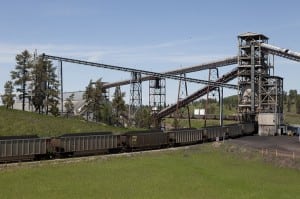Nation’s Oldest Independent Coal Producer Files Bankruptcy
Colorado-based Westmoreland Coal Co. on October 9 said it had filed for Chapter 11 bankruptcy, with the company reporting more than $1.4 billion in debt. The company in its annual financial report in April of this year said it was considering bankruptcy in an effort to protect it from creditors.
Westmoreland, which has operated for 164 years, is the oldest independent U.S. coal company. It is the fourth major U.S. coal producer to file for bankruptcy protection in the past three years. Alpha Natural Resources went into bankruptcy in 2015, and Arch Coal and Peabody Energy filed bankruptcy petitions the following year.
Coal producers have struggled in recent years with lower demand for their product as U.S. coal-fired power generation has diminished due to environmental regulations and the rise of natural gas-fired and renewable generation, leading to the closure of dozens of coal plants. Westmoreland closed its coal-fired Roanoke Valley Energy Facility in Weldon, North Carolina, in 2017. The company earlier this year disclosed a major customer in Ohio that accounted for 14% of its revenue had not renewed coal supply contracts that expire at the end of this year. Reports say that customer is American Electric Power, which this week confirmed it will close its 1.59-GW coal-fired Conesville power plant in Ohio by the end of May in 2020, two years earlier than originally planned.
Westmoreland, headquartered in Englewood, Colorado, a Denver suburb, in a statement said it does not expect its operations to be interrupted by the filing. The company, which has about 3,000 workers and operations in several states, including the Powder River Basin in Wyoming and Montana, and Canada, also said it does not plan staff reductions. Its bankruptcy filing in the U.S. Bankruptcy Court in Houston, Texas, said the company has entered a restructuring agreement with its lenders.
Michael Hutchinson, who has served as the company’s interim CEO since November 2017 and served on the company’s board since 2012, in a statement Tuesday said, “After months of thoughtful and productive conversations with our creditors, we have developed a plan that allows Westmoreland to operate as usual while positioning Westmoreland for long-term success. We will continue to serve our customers in the normal course as we progress through an expedited process to restructure our long-term debt and other liabilities.”
The company in May of this year secured a $110 million financing agreement. Hutchinson at the time said, “This financing also provides us with the financial flexibility to develop a longer-term plan while soliciting input from a number of our key constituents, who all want to see Westmoreland continue to grow and prosper. In the months ahead, we will continue our evaluation and determine the appropriate strategic, operational and financial structure to support the continued future growth of our business.”

Jeffrey Stein, Westmoreland’s chief restructuring officer, said in the bankruptcy filing that “coal mining businesses across the U.S. and around the world are feeling pressure as a result of a variety of macroeconomic factors, and the fate of many of these companies is yet to be determined. President Donald Trump has made support of the coal industry a priority of his administration and the Environmental Protection Agency is rolling back several regulations that limited greenhouse gas (GHG) emissions from power plants. Trump’s EPA recently unveiled the Affordable Clean Energy (ACE) ruleas a replacement for President Barack Obama’s Clean Power Plan, which was never enacted amid numerous legal challenges.
The ACE rule gives states more leeway to develop their own GHG regulations.
Mary Anne Hitt, senior director of the Sierra Club’s Beyond Coal campaign, in a statement said Westmoreland’s bankruptcy is the “latest clear signal that the coal industry is in an irreversible decline.” Hitt said, “With numerous coal companies facing bankruptcy in recent years, it is clear that further investments in coal are a mistake. The best course for Westmoreland Coal Company moving forward must be to ensure that there are adequate funds to clean up its mines and to treat its workers with the respect they deserve. Nothing can stop America’s shift away from coal and toward clean energy, but the transition should be managed to ensure workers are treated with respect and that vital environmental obligations are honored.”
A Westmoreland affiliate, Westmoreland Resource Partners, LP (WMLP), also Tuesday filed for Chapter 11 protection. WMLP said it has agreed to terms with its secured creditors on the use of cash collateral to finance the company’s continued operations during the bankruptcy case.
Among the top creditors listed in Westmoreland’s filing—which claims more than $1.4 billion in debt and total assets of $770 million, as of Aug. 31—is the Bureau of Indian Affairs, which is owed $1.8 million. Another creditor is former Westmoreland CEO Kevin Paprzycki, who left the company in 2017 and is owed more than $1.1 million.
Westmoreland’s Absaloka Mine in Montana has been a revenue generator for the Crow Tribe. The company’s Rosebud Mine in Montana supplies the Colstrip power plant. The company in its annual report in April said neither mine had sales of coal under contract past 2019.
Units 1 and 2 at the Colstrip plant are scheduled to close no later than 2022 according to the terms of an air pollution lawsuit settled in 2016. Units 3 and 4 at Colstrip have been closed for much of this year due to failed emissions tests under the federal Mercury and Air Toxics Standards (MATS) rule. Plant co-owner Talen Energy, which operates the plant, in late September said all four units were operating after mid-September tests showed Units 3 and 4 were in compliance with particulate matter limits.
A Talen spokesman in August 2017 told POWERthe company would continue to operate the 2,094-MW plant, after an executive with the company in 2016 said the plant was not economically viable.
—Darrell Proctor is a POWER associate editor (@DarrellProctor1, @POWERmagazine).